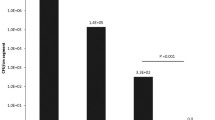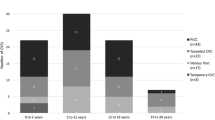Summary
Infection of central venous catheters (CVC) is a relatively common occurrence in immunocompromised patients, management of which has included I.V. antibiotics ± removal of catheter. We have previously demonstrated that intracatheter administration of Amikacin empirically, successfully eradicated all bacterial infections except those due to S. epidermidis. A study was subsequently undertaken to treat gram positive cocci infections of CVC with intracatheter Teicoplanin. Eleven patients attending a single institution with documented gram positive cocci infection of CVC over a one year period were included in the study. Teicoplanin was instilled with heparinised saline once daily into the infected lumen of the CVC and allowed to remain for 24 hours. Treatment was continued for 48 hours after negative cultures were reported. Teicoplanin was successful in eradicating infection in 100% of cases. Mean duration of treatment was six days (range 4–9 days). Four patients subsequently developed a further infection, a mean of 13 weeks from first infection, only one of which was due to the same organism and this was successfully treated by a further course of Teicoplanin. No side effects were reported and catheter life was prolonged a mean of 132 days after completion of treatment. The use of Teicoplanin in this way for treatment of gram positive cocci infection of CVC is highly effective; once daily administration of antibiotic enables treatment to be given on an outpatient basis, thereby minimising hospital admission.
Similar content being viewed by others
References
Harms, D., Gortitz, I., Lambrecht, W. et al. Infectious risks of broviac catheters in children with neoplastic diseases: a matched pairs analysis. Pediatr. Infect. Dis. J. 1992; 11: 1014–8.
Decker, M. D., Edwards, K. M. Central venous catheter infections. Ped. Clin. N. Am. 1988; 35: 579–605.
Flynn, P. M., Shenep, J. L., Stokes, D. C., Barrett, F. F. In-situ management of confirmed central venous catheter - related bacteraemia. Paediatr. Infect. Dis. J. 1987; 6:729–734.
Rao, J. S., O’Meara, A., Harvey, T., Breatnach, F. A new approach to the management of Broviac catheter infection. J. Hosp. Infect. 1992; 22: 109–116.
Brogden, R. N., Peters, D. H. Teicoplanin. A reappraisal of its antimicrobial activity, pharmacokinetic properties and therapeutic efficacy. Drugs 1994; 5: 823–854.
Schwartz, C., Henrickson, K. J., Roghmann, K., Powell, K. Prevention of bacteremia attributed to luminal colonization tunnelled central venous catheters with vancomycin susceptible organisms. J. Clin. Oncol. 1990; 8:1591–1597.
Fishbrin, J. D., Friedman, H. S., Bennett, B. B., Falletta, J. M. Catheter-related sepsis refractory to antibiotics treated successfully with adjunctive urokinase infusion. Pediatr. Infect. Dis. J. 1990; 9: 676–8.
Author information
Authors and Affiliations
Rights and permissions
About this article
Cite this article
McCarthy, A., Byrne, M., Breathnach, F. et al. “In-Situ” Teicoplanin for central venous catheter infection. I.J.M.S. 164, 125–127 (1995). https://doi.org/10.1007/BF02973277
Issue Date:
DOI: https://doi.org/10.1007/BF02973277




